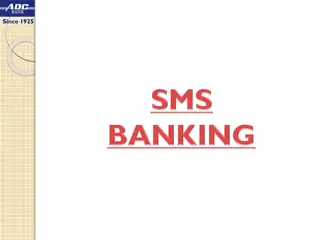Understanding Money and Banking: Basics and Systems
Money and banking concepts explained with emphasis on the functions of money as a medium of exchange, unit of account, and store of value. Details on currency, characteristics of money, Federal Reserve System, and the role of FDIC post the Great Depression are covered.
Download Presentation

Please find below an Image/Link to download the presentation.
The content on the website is provided AS IS for your information and personal use only. It may not be sold, licensed, or shared on other websites without obtaining consent from the author. Download presentation by click this link. If you encounter any issues during the download, it is possible that the publisher has removed the file from their server.
E N D
Presentation Transcript
Money exchange, a unit of account and a store of value Money is anything that serves as a medium of
1) Medium of exchange used to determine value during the exchange of goods and services 2) Unit of account values of goods and services 3) Store of value value if it is stored rather than used Medium of exchange- anything that is Unit of account- a means of comparing the Store of value- something that keeps its
The coins and paper bills used as money in a society are called currency currency.
1) Durability withstand wear and tear 2) Portability transfer 3) Divisibility amounts Durability- Objects used as money must Portability- Easy to carry around and Divisibility- Easily divided into smaller
4) Uniformity identical 5) Limited Supply controls supply of money in circulation 6) Acceptability be able to exchange the objects that serve as money for goods and services Uniformity- all units of money must be Limited Supply- Federal Reserve System Acceptability- everyone in economy must
In 1913,the Federal Reserve System Act established the Federal Reserve System. The Fed is the nations central bank that creates national currency called Federal Reserve Notes.
After the Great Depression, the Federal Deposit Insurance Corporation (FDIC) was created to instill trust in banking system. Today the FDIC insures customer deposits up to $250,000 if a bank fails.
The money supply in the U.S. economy. money supply is all the money available
Banks perform many functions and offer many services to consumers 1) Store money- its safe and convenient 2) Credit Cards- cards entitling their holders to buy goods and services based on the card holders promise to pay
3) Saving money- the most common options are: Savings accounts Checking accounts Money Market Accounts Certificates of Deposits (CDs)
4) Loans- Make loans to help new businesses and help established businesses' grow 5) Mortgages- a specific loan used to purchase real estate
Banks make money of interest rates they receive from consumers who have taken loans Interest is the price paid on the use of borrowed money
The rise of computers in banking as increased dramatically Automated Teller Machines (ATM)- can deposit, withdraw cash and obtain account information Debit Cards- used to withdraw money from checking account
Automatic Clearing Houses (ACH)- transfer funds from customers accounts into creditors accounts Home Banking- can check balances or make transfers from home computer Store Value Cards- have magnetic strips or computer chips with account balance information























